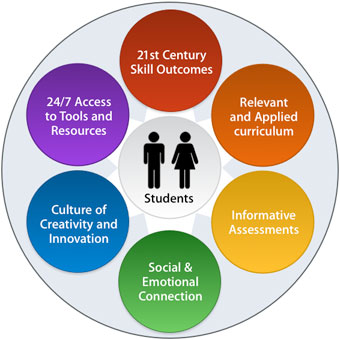Design Principles for the 21st century school
Apple Classroom of Tomorrow has identified six design principles for the 21st century high school
|
Understanding of 21st Century Skills and Outcomes Establishes as a baseline that educators, students and parents must be well versed in the 21st century skills that students need to acquire to be successful. Teachers should be able to make relevant and useful choices about when and how to teach them, and whether or not students are making progress toward their personal demonstration of accomplishment. Rethinking what we teach must come before we can rethink how we teach |
 |
Relevant and Applied Curriculum Offers an innovative vision of what the learning environment should become by applying what we know about how people learn and adapting the best pedagogy to meet the needs of this generation of learners. Students should be engaged in relevant and contextual problem- and project-based learning designed to develop 21st century skills and provided using a multi-disciplinary approach. Curriculum should apply to students' current and future lives and leverage the power of Web 2.0 and ubiquitous technologies |
|
|
Informative Assessment Identifies the types and systems of assessments schools need to develop to fully capture the varied dimensions of 21st century learning as well as the independent role students need to take on in monitoring and adjusting their own learning. Assessments used in the classroom should increase relevant feedback to students, teachers, parents, and decision-makers and should be designed to continuously improve student learning and inform the learning environment |
A Culture of Innovation and Creativity Acknowledges the fuel that drives today's global economy and, in turn, its importance in both student learning and the school environment. As a result, schools should create a culture that supports and reinforces innovation for student learning and leverages the creativity and ingenuity of every adult and student to solve their unique problems. Additionally, the teaching and learning environment should generate the continuous development of these skills
|
Social and Emotional Connections with Students Gives appropriate recognition to the personal, professional, and familial relationships that determine the health, growth, and cognitive development of a child within the family, school, and community. Specifically, each student should have a clear and purposeful connection to the social environment in school, with at least one adult who is purposefully in tune with the student's learning preferences, learning interests, and social connections |
Ubiquitous Access to Technology Underscores the essential role technology plays in 21st century life and work and, consequently, the role that it must play in learning. Students and educators need 24 by 7 access to information, resources, and technologies that engage and empower them to do background research, information and resource gathering, and data analysis, to publish with multiple media types to wide and varied audiences, to communicate with peers and experts, and to gain experience and expertise in collaborative work |

